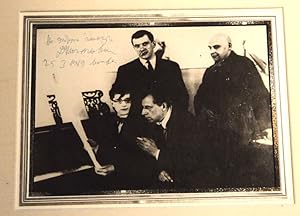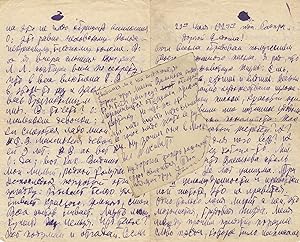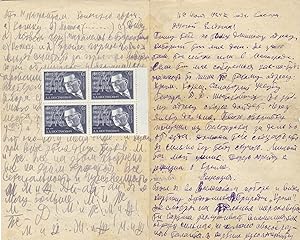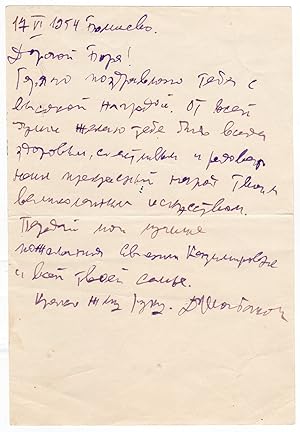Shostakovich Dmitri, Signed (9 results)
FeedbackSearch filters
Product Type
- All Product Types
- Books (7)
- Magazines & Periodicals (No further results match this refinement)
- Comics (No further results match this refinement)
- Sheet Music (No further results match this refinement)
- Art, Prints & Posters (No further results match this refinement)
- Photographs (No further results match this refinement)
- Maps (No further results match this refinement)
- Manuscripts & Paper Collectibles (2)
Condition
- All Conditions
- New (No further results match this refinement)
- Used (9)
Binding
- All Bindings
- Hardcover (2)
- Softcover (No further results match this refinement)
Collectible Attributes
Language (1)
Price
- Any Price
- Under £ 20 (No further results match this refinement)
- £ 20 to £ 35 (No further results match this refinement)
- Over £ 35
Free Shipping
Seller Location
Seller Rating
-
Derek C Hulme [Dmitri Shostakovich]
Published by Muir of Ord, Ross-shire Kyle and Glen Music 1982, 1982
Seller: Christian White Rare Books Ltd, Ilkley, YORKS, United Kingdom
First Edition Signed
Condition: Very Good. pp 247 [2] The self-published first edition of Derek Hulme's Shostakovich catalogue with an interesting two page autograph letter from the author laid in. The letter which is dated 1991 goes into some detail about a recent exchange of musical cassettes of Shostakovich's music and the price of the second edition of this book putting it 'out of the reach of general music-lovers'. The book is very good in a near very good jacket. Very Good Please contact Christian White Rare Books Ltd for more information or images of this item.
-
Shostakovich Reconsidered
Published by Toccata Press, Exeter, 1998
Seller: North Books: Used & Rare, Manchester, NH, U.S.A.
First Edition Signed
£ 72.54
Convert currency£ 37.07 shipping from U.S.A. to United KingdomQuantity: 1 available
Add to basketHardcover. First Edition, First Printing. 5.5 x 8.75in. 787pp. Publisher's cloth boards. Signed and briefly inscribed by the editor, Allan B. Ho, on the title page. NEAR FINE in Near Fine dust jacket. Both the book itself and dust jacket show marginal shelf rubbing of the extremities, otherwise remain Fine/As New. As pictured.
-
Autograph Manuscript unsigned.
Published by no place, [1950], 1950
Manuscript / Paper Collectible Signed
£ 6,697.23
Convert currency£ 17.34 shipping from Germany to United KingdomQuantity: 1 available
Add to basket8vo. 1 1/2 pp. With the original envelope signed, "DShostakovich," and addressed in his hand to the "Literary Bureau of Great Britain," in Russian, lacking postal markings. A speech [for the Sheffield World Congress of the Supporters of Peace], in Russian. "The ties between the Soviet Union and England are unbreakable. In the first years of the revolution, English workers protested with the slogan 'Hands off Soviet Russia!' When fascism was defeated in the last war, people of the Soviet Union saved England and Europe from immanent catastrophe. "Our peoples of the Soviet Union and England, shoulder to shoulder, are joining in the fight for peace. . . . "Artists, composers, writers, workers in all of the arts are the voice of consciousness of all the people, and that's why that voice should loudly rumble against the war. Under the protection of peace, and under the protection of Democracy, artists, statesmen of England, workers of all countries, expand and strengthen the powerful front of the Supporters of Peace." The second World Congress of the Supporters of Peace was scheduled to be held in Sheffield, England, in November of 1950. Because the British government suspected that the meeting organizers had seditious objectives and represented a threat to national security, the visa applications of a vast majority of the delegates were declined. Consequently, the meeting was moved to Warsaw, Poland. Among the delegates who were turned away was Shostakovich.
-
A SIGNIFICANT PHOTOGRAPH INSCRIBED & SIGNED BY DMITRI SHOSTAKOVICH. A most famous photograph of this important gathering of Russian artists, each of whom contributed to the play "The Bedbug", inscribed and signed by the great modern Russian composer.
Published by Moscow, 1969., 1969
Seller: Blue Mountain Books & Manuscripts, Ltd., Cadyville, NY, U.S.A.
Signed
£ 5,726.92
Convert currency£ 48 shipping from U.S.A. to United KingdomQuantity: 1 available
Add to basketCondition: Very good. INSCRIBED AND SIGNED BY SHOSTAKOVICH - sc A 6-1/2 inch high by 9-1/4 inch wide black & white gelatin silver photograph distributed by the photographic agency of H. Roger Viollet, with their stamp on the verso. This famous image from September 19, 1929, depicts the young bespectacled Shostakovich seated at the piano holding up a sheet of the music for the Bedbug so that Meyerhold, the director of the play who is seated next to the composer with a cigarette in hand, can look at the page. Standing behind the two, a cigarette dangling from his mouth, is the poet and author of the play Vladimir Mayakovsky with the great painter and photographer Alexander Rodchenko who designed the sets for the production, standing at the viewer's right. Shostakovich has inscribed the photograph at the top left in Russian with words equivalent to "Best Wishes". The inscription and signature, penned in blue ink, is signed "D. Shostakovich" and dated "25 I 1969 Mokba". The photographic agent's credits, stamped on the verso, state "H.Roger Viollet / 6, Rue de Seine, Paris - 6e / Tel. ODE. 81-10 / Attention Obligatoire / Collection Viollet". This particular signed photograph is from the collection of the autograph collector and scholar Ray Rawlins, who wrote numerous books on the subject, with his discreet oval collector's mark stamped at the bottom right of the verso, illustrated with a device of an arm holding an arrow and the words "Rawlins Collection: Historical Docs and ALS". The photo is further annotated in pencil on the verso: "RV 40877 / Theatre Meyerhold / le compositeur, Chostakovitch / qui a compose la musique de la Punaise / assis a ses cote Meyerhold / debout de gauche a droite: / le poete Maiakisky, auteur de la Punaise / et l'artiste Rodchenko qui s'occupe des decors pour 'la Punaise'." There are light brownish diagonal stains to the lower left of the verso with some minor creasing. The photograph is mounted into a mat with document tape from the top corners of the verso. The image itself has but some light spotting to the image and minor soiling to the left edge, likely due to the overlap of the mat. There is some very minor fading and some very few spots most likely the result of the developing process. A rare and very significant signed photograph.Provenance: From the collection of Ray Rawlins, author of "The Stein and Day Book of World Autographs". Along with Meyerhold, Mayakovsky and Rodchenko, Shostakovich embraced the Soviet Revolution which, by its nature, seemed to promise to liberate the arts from the constraints of staid conservative tradition. And though the promise seemed to hold true at first, allowing great creativity and experimentation, the artists were to find themselves criticized by those in power with little tolerance for those whose work even hinted at opposition. Shostakovich found himself alternately being hailed as a hero of Soviet music, denounced as a formalist and attacked by Pravda. Such denunciation in Stalinist Russia could well lead to arrest. Indeed many of Shostakovich's friends and family were arrested or executed during the years of terror. In the early period from 1921 to 1927, the Bolshevik's experimentation with a New Economic Policy allowing some limited private enterprise resulted in considerable freedom and the arts flourished. Even criticism of the NEP and government policy was tolerated to some degree. But the line was always a fine one and by 1927 Stalin tightened his grip on the economy and the arts. It was in the period following 1928, the year Stalin buried the NEP, that the futurist poet Mayakovsky wrote his play "Klop" [The Bedbug] for Meyerhold. It was an ambiguous satire of Soviet society. Shostakovich composed the incidental music for the play, his Opus 19.
-
Dmitri Shostakovich Autograph Musical Quotation Signed.
Publication Date: 1947
Seller: Raptis Rare Books, Palm Beach, FL, U.S.A.
First Edition Signed
£ 6,719.58
Convert currency£ 40.77 shipping from U.S.A. to United KingdomQuantity: 1 available
Add to basketHandwritten musical quotation inscribed by Russian composer and pianist Dmitri Dmitriyevich Shostakovich in Russian above the opening three bars of Shostakovich's Symphony No. 5 in D minor (Op. 47) on a two-stave system with holograph tempo directive and title, "To Lionel Okvin from Dmitri Shostakovich 17th February 1947." Double matted and framed with a photograph of Shostakovich. The entire piece measures 14.75 inches by 15.75 inches. Rare and desirable. Regarded as one of the major composers of the 20th century, Russian pianist Dmitri Dmitriyevich Shostakovich's orchestral works include 15 symphonies and six concerti in addition to three operas, several ballets, and a considerable quantity of film scores including music to the 1956 film The First Echelon. Shostakovich achieved fame in the Soviet Union under the patronage of Soviet chief of staff Mikhail Tukhachevsky, but later had a complex and difficult relationship with the government. Musicologist David Fanning concludes in Grove's Dictionary that, "Amid the conflicting pressures of official requirements, the mass suffering of his fellow countrymen, and his personal ideals of humanitarian and public service, he succeeded in forging a musical language of colossal emotional power.".
-
Autograph musical quotation from the composer's Sixth Symphony, signed [in Cyrillic] "D Shostakovich"
Seller: J & J LUBRANO MUSIC ANTIQUARIANS LLC, Syosset, NY, U.S.A.
Signed
£ 4,829.70
Convert currency£ 40.77 shipping from U.S.A. to United KingdomQuantity: 1 available
Add to basket3 measures of the theme from the first movement, marked "Moderato" at head. Notated in blue ink on letterhead of the Hotel Victoria in Rome, with their logo in blue to upper left corner. Quarto (190 x 175 mm). With an autograph inscription in Cyrillic to Joseph Nicolas ("To Zhosefu Niklasu with best wishes from D. Shostakovich") dated 17 May 1958, Rome below quotation. Slightly creased at folds. "Shostakovich's most significant work from these times [1939-1941] was the Sixth Symphony, composed between April and October 1939. This work disappointed those who were expecting something on the lines of the Fifth, but its bizarre succession of apparently unrelated moods parallels the profoundly contradictory spirit of the times." Laurel Fay and David Fanning in Grove Music Online Shostakovich "is generally regarded as the greatest symphonist of the mid-20th century, and many of his string quartets, concertos, instrumental and vocal works are also firmly established in the repertory. . He played a decisive role in the musical life of the former Soviet Union, as teacher, writer and administrator. He was also an active pianist, frequently performing his own works until disability prevented him. His last concert appearance was in 1966." Laurel Fay and David Fanning in Grove Music Online.
-
Autograph letter signed ("D. Shostakovich") from the young composer to his closest friend at the time, noted Russian musicologist, critic, and composer Valerian Bogdanov-Berezovsky. With musical content
Seller: J & J LUBRANO MUSIC ANTIQUARIANS LLC, Syosset, NY, U.S.A.
Signed
£ 3,951.57
Convert currency£ 40.77 shipping from U.S.A. to United KingdomQuantity: 1 available
Add to basket4 pp. of a bifolium. Octavo. Plus postscript on a small slip of paper ca. 98 x 80 mm laid in. In purple ink. Addressed to "Eldosha" (nickname). Dated Gaspra, Crimea, 29 July 1924. In Cyrillic (with translation). The not quite 18-year-old composer writes from the spa town of Gaspra, where he was sent to recuperate after contracting tuberculosis in 1923. After a somewhat obscene introduction, Shostakovich thanks Bogdanov-Berezovsky for inquiring about his work and states: "I have started a fugue in eight parts and have finished one orchestral scherzo that I wrote for two pianos. It is brilliant!," promising to show it to his correspondent when he sees him and suggesting that they organize a concert with "somebody's symphony" first followed by Bogdanov-Berezovsky's concerto for piano and intermezzo and then three of Shostakovich's scherzos. Shostakovich goes on to pose a playful series of questions and answers about life and love and includes a joke about how "one German used to say how difficult the Russian language is" as a postscript. With several minor autograph corrections. Slightly worn, browned, and creased; small purple ink stain to blank area at head. Shostakovich "is generally regarded as the greatest symphonist of the mid-20th century, and many of his string quartets, concertos, instrumental and vocal works are also firmly established in the repertory. . He played a decisive role in the musical life of the former Soviet Union, as teacher, writer and administrator. He was also an active pianist, frequently performing his own works until disability prevented him. His last concert appearance was in 1966. . In March 1924 Shostakovich was excluded from the post graduate piano course [at the Petrograd Conservatory], officially because of 'insufficient maturity'; he came close to transferring to the Moscow Conservatory, where he already had a number of friendly contacts, to study piano with Konstantin Igumnov and composition with Nikolay Myaskovsky. After he had enjoyed a second rest-cure in the Crimea he was reinstated with Nikolayev in Leningrad. He set to work in earnest on his symphony, now a prescribed graduation task." Laurel Fay and David Fanning in Grove Music Online Shostakovich considered Valerian Mikhailovich Bogdanov-Berezovksy (1903-1971) his closest friend during his years at the Conservatory; Bogdanov-Berezovsky went on to become one of the leading Soviet musicologists and critics of his generation. "Shostakovich's friendship with Bodgdanov-Berezovsky coincided with the most eventful years of his personal development, when the teenager displaying signs of outstanding creative talent became a young man with touchingly child-like sides to his nature. His letters to his friend reveal a wide range of emotional responses - tenderness, sensitivity, ardent devotion, irascibility, deep impressionability, morbid vulnerability - such are the 'passions' of teenagers discovering themselves and others through the tangled weave of personal relations. We observe the bitterness of first betrayals and losses, the forging of the shield of psychological defenses, the curiously contradictory combination of pliancy and pig-headedness, caustic ironic criticism of others and of himself, empty chatter about trifles and presentiments of what is truly important. The attentive reader will discern signs of a complex process of maturation as Shostakovich shed one skin after another through experience of life. These letters from the 1920s reveal his inner world with a remarkable immediacy and fullness, as though his soul was laid bare. We can also observe the origins of Shostakovich's epistolary stock phrases and his teenage love of bad language, which he uses to express the chastest of feelings and to formulate what would become enduring convictions. The letters abound in nicknames, which the young Shostakovich adored and which he employed with virtuosic aplomb. . In former decades, such letters could scarcely have been published, mainly on account of their vocabulary. The 15-year-old Mitya Shostakovich did not give external censorship a thought: it only became a concern later in the 1930s, on account of the mass repressions and the devastating criticism directed at him by the Communist party. But internal censorship is also absent . . "The correspondence between the two men is of exceptional interest, as it offers a unique insight into Shostakovich's character and artistic outlook at a crucial formative period. Unlike the composer's later correspondence, in which he expressed himself with far greater circumspection, these letters are wholly free from self-censorship and reveal his innermost thoughts about life, love, and art with unusual frankness. The exuberant personality that they reveal stands in marked contrast to the 'official' public persona that Shostakovich adopted subsequently in his dealings with the outside world." Kovnatskaya: Portrait of the Artist as a Young Man: The Shostakovich-Bogdanov-Berezovsky Correspondence in Zuk and Frolova-Walker, eds.: Russian Music Since 1917, abstract and pp. 272-3. An early letter with good musical content, written at a highly formative period in the composer's career, offering important insights into the relationship of Shostakovich and his closest friend as young men.
-
Autograph letter signed ("D") from the young composer to his closest friend at the time, Russian musicologist, critic, and composer Valerian Bogdanov-Berezovsky
Seller: J & J LUBRANO MUSIC ANTIQUARIANS LLC, Syosset, NY, U.S.A.
Signed
£ 3,336.88
Convert currency£ 40.77 shipping from U.S.A. to United KingdomQuantity: 1 available
Add to basket4 pp. of a bifolium (2-1/2 pp. in purple ink, 1-1/2 pp. in pencil). Octavo. Addressed to "Eldosha" (nickname). Dated Gaspra, Crimea, 16 July 1924. In Cyrillic (with translation). A very colorful, personal, cryptic, and at times somewhat obscene, letter, from the not quite 18-year-old composer in which he writes to his best friend, telling him that he misses him very much and sending his "review of Crimea," where he was sent to the spa town of Gaspra to recuperate after contracting tuberculosis in 1923. The composer details his visit to the Vselenskii Cathedral where he admired the frescoes, stating "This artist deserves attention as an example of powerful and original talent." He then goes into detailed descriptions of each fresco in something of a stream-of-consciousness style, replete with wordplay and strong sexual references, including to Leonid Nikolayev, his piano teacher in Leningrad, as a homosexual. With several minor autograph corrections. Slightly worn and browned; creased at folds and very slightly overall; light brown staining to central portion; small hole to central fold, not affecting text. Together with: A block of 4 Russian commemorative stamps with a bust-length portrait of the composer and several bars of music. Shostakovich "is generally regarded as the greatest symphonist of the mid-20th century, and many of his string quartets, concertos, instrumental and vocal works are also firmly established in the repertory. . He played a decisive role in the musical life of the former Soviet Union, as teacher, writer and administrator. He was also an active pianist, frequently performing his own works until disability prevented him. His last concert appearance was in 1966. . In March 1924 Shostakovich was excluded from the post graduate piano course [at the Petrograd Conservatory], officially because of 'insufficient maturity'; he came close to transferring to the Moscow Conservatory, where he already had a number of friendly contacts, to study piano with Konstantin Igumnov and composition with Nikolay Myaskovsky. After he had enjoyed a second rest-cure in the Crimea he was reinstated with Nikolayev in Leningrad. He set to work in earnest on his symphony, now a prescribed graduation task." Laurel Fay and David Fanning in Grove Music Online Shostakovich considered Valerian Mikhailovich Bogdanov-Berezovksy (1903-1971) his closest friend during his years at the Conservatory; Bogdanov-Berezovsky went on to become one of the leading Soviet musicologists and critics of his generation. "Shostakovich's friendship with Bodgdanov-Berezovsky coincided with the most eventful years of his personal development, when the teenager displaying signs of outstanding creative talent became a young man with touchingly child-like sides to his nature. His letters to his friend reveal a wide range of emotional responses - tenderness, sensitivity, ardent devotion, irascibility, deep impressionability, morbid vulnerability - such are the 'passions' of teenagers discovering themselves and others through the tangled weave of personal relations. We observe the bitterness of first betrayals and losses, the forging of the shield of psychological defenses, the curiously contradictory combination of pliancy and pig-headedness, caustic ironic criticism of others and of himself, empty chatter about trifles and presentiments of what is truly important. The attentive reader will discern signs of a complex process of maturation as Shostakovich shed one skin after another through experience of life. These letters from the 1920s reveal his inner world with a remarkable immediacy and fullness, as though his soul was laid bare. We can also observe the origins of Shostakovich's epistolary stock phrases and his teenage love of bad language, which he uses to express the chastest of feelings and to formulate what would become enduring convictions. The letters abound in nicknames, which the young Shostakovich adored and which he employed with virtuosic aplomb. . In former decades, such letters could scarcely have been published, mainly on account of their vocabulary. The 15-year-old Mitya Shostakovich did not give external censorship a thought: it only became a concern later in the 1930s, on account of the mass repressions and the devastating criticism directed at him by the Communist party. But internal censorship is also absent . . "The correspondence between the two men is of exceptional interest, as it offers a unique insight into Shostakovich's character and artistic outlook at a crucial formative period. Unlike the composer's later correspondence, in which he expressed himself with far greater circumspection, these letters are wholly free from self-censorship and reveal his innermost thoughts about life, love, and art with unusual frankness. The exuberant personality that they reveal stands in marked contrast to the 'official' public persona that Shostakovich adopted subsequently in his dealings with the outside world." Kovnatskaya: Portrait of the Artist as a Young Man: The Shostakovich-Bogdanov-Berezovsky Correspondence, abstract and pp. 272-3 in Zuk and Frolova-Walker, eds.: Russian Music Since 1917 An early letter, written at a highly formative period in the composer's career, offering important insights into the relationship of Shostakovich and his closest friend as young men.
-
Scarce autograph letter signed to actor Boris Livanov
Seller: Andreas Wiemer Historical Autographs, Kelkheim, Germany
Manuscript / Paper Collectible Signed
£ 1,374.46
Convert currencyFree shipping from Germany to United KingdomQuantity: 1 available
Add to basketKein Einband. Condition: Sehr gut. Shostakovich, Dmitri (1906-1975) - Scarce autograph letter signed to actor Boris Livanov - Russian composer, pianist and a prominent figure of 20th-century music. Autograph letter signed "D. Shostakovich". 1p., 5.0 x 7.5 inch, Moscow, 1954 June 17. A fine letter in Russian to Boris N. Livanov. He congratulates him on a high award. With all his heart he wishes that he always stays happy and healthy and continues to enchant "our wonderful people" with his great art. Mailing fold, minor handling wear, else fine condition. Boris Nikolayevich Livanov (1904-1972) was a Soviet and Russian actor and theatre director. People's Artist of the USSR (1948) and a member of the Moscow Art Theatre from 1924 through 1972. Shostakovich is uncommon in handwritten letters. COMES WITH A CERTIFICATE OF AUTHENTICITY BY ANDREAS WIEMER HISTORICAL AUTOGRAPHS. Please do not hesitate to contact me with any questions. Signatur des Verfassers.


![Seller image for Derek C Hulme [Dmitri Shostakovich] for sale by Christian White Rare Books Ltd](https://pictures.abebooks.com/inventory/md/md30793235992.jpg)




![Seller image for Autograph musical quotation from the composer's Sixth Symphony, signed [in Cyrillic] "D Shostakovich" for sale by J & J LUBRANO MUSIC ANTIQUARIANS LLC](https://pictures.abebooks.com/inventory/md/md31813012922.jpg)


